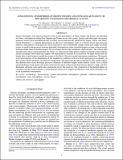Files in this item
Ionization in atmospheres of brown dwarfs and extrasolar planets III. Breakdown conditions for mineral clouds
Item metadata
| dc.contributor.author | Helling, Christiane | |
| dc.contributor.author | Jardine, Moira Mary | |
| dc.contributor.author | Stark, Craig Ronald | |
| dc.contributor.author | Diver, D. | |
| dc.date.accessioned | 2014-05-09T12:01:00Z | |
| dc.date.available | 2014-05-09T12:01:00Z | |
| dc.date.issued | 2013-04-20 | |
| dc.identifier | 74455307 | |
| dc.identifier | 0ded56f6-8b61-496e-9de0-5569c0c9087d | |
| dc.identifier | 000317346800039 | |
| dc.identifier | 84876158696 | |
| dc.identifier.citation | Helling , C , Jardine , M M , Stark , C R & Diver , D 2013 , ' Ionization in atmospheres of brown dwarfs and extrasolar planets III. Breakdown conditions for mineral clouds ' , Astrophysical Journal , vol. 767 , no. 2 , 136 . https://doi.org/10.1088/0004-637X/767/2/136 | en |
| dc.identifier.issn | 0004-637X | |
| dc.identifier.other | BibCode: 2013ApJ...767..136H | |
| dc.identifier.other | ORCID: /0000-0002-1466-5236/work/57821832 | |
| dc.identifier.uri | https://hdl.handle.net/10023/4749 | |
| dc.description.abstract | Electric discharges were detected directly in the cloudy atmospheres of Earth, Jupiter, and Saturn, are debatable for Venus, and indirectly inferred for Neptune and Uranus in our solar system. Sprites (and other types of transient luminous events) have been detected only on Earth, and are theoretically predicted for Jupiter, Saturn, and Venus. Cloud formation is a common phenomenon in ultra-cool atmospheres such as in brown dwarf and extrasolar planetary atmospheres. Cloud particles can be expected to carry considerable charges which may trigger discharge events via small-scale processes between individual cloud particles (intra-cloud discharges) or large-scale processes between clouds (inter-cloud discharges). We investigate electrostatic breakdown characteristics, like critical field strengths and critical charge densities per surface, to demonstrate under which conditions mineral clouds undergo electric discharge events which may trigger or be responsible for sporadic X-ray emission. We apply results from our kinetic dust cloud formation model that is part of the Drift-Phoenix model atmosphere simulations. We present a first investigation of the dependence of the breakdown conditions in brown dwarf and giant gas exoplanets on the local gas-phase chemistry, the effective temperature, and primordial gas-phase metallicity. Our results suggest that different intra-cloud discharge processes dominate at different heights inside mineral clouds: local coronal (point discharges) and small-scale sparks at the bottom region of the cloud where the gas density is high, and flow discharges and large-scale sparks near, and maybe above, the cloud top. The comparison of the thermal degree of ionization and the number density of cloud particles allows us to suggest the efficiency with which discharges will occur in planetary atmospheres. | |
| dc.format.extent | 12 | |
| dc.format.extent | 1091916 | |
| dc.language.iso | eng | |
| dc.relation.ispartof | Astrophysical Journal | en |
| dc.subject | astrobiology | en |
| dc.subject | brown dwarfs | en |
| dc.subject | planets and satellites: atmospheres | en |
| dc.subject | plasmas | en |
| dc.subject | radiation mechanisms: non-thermal | en |
| dc.subject | stars: atmospheres | en |
| dc.subject | X-rays: bursts | en |
| dc.subject | Hubble-space-telescope | en |
| dc.subject | Dust formation | en |
| dc.subject | Stellar winds | en |
| dc.subject | HD 189733B | en |
| dc.subject | Growth | en |
| dc.subject | Electrification | en |
| dc.subject | Simulations | en |
| dc.subject | Discharges | en |
| dc.subject | Particles | en |
| dc.subject | Scales | en |
| dc.subject | QC Physics | en |
| dc.subject.lcc | QC | en |
| dc.title | Ionization in atmospheres of brown dwarfs and extrasolar planets III. Breakdown conditions for mineral clouds | en |
| dc.type | Journal article | en |
| dc.contributor.sponsor | Science & Technology Facilities Council | en |
| dc.contributor.institution | University of St Andrews. School of Physics and Astronomy | en |
| dc.identifier.doi | https://doi.org/10.1088/0004-637X/767/2/136 | |
| dc.description.status | Peer reviewed | en |
| dc.identifier.url | http://adsabs.harvard.edu/abs/2013ApJ...767..136H | en |
| dc.identifier.grantnumber | ST/J001651/1 | en |
This item appears in the following Collection(s)
Items in the St Andrews Research Repository are protected by copyright, with all rights reserved, unless otherwise indicated.

